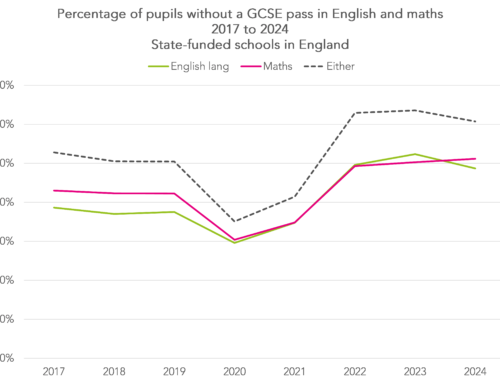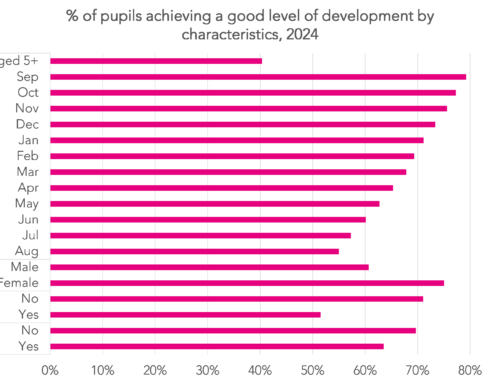While undertaking analysis of the National Pupil Database (NPD) to produce our recent post-Timpson Review blogposts (like this and this), I became intrigued by a strange phenomenon in which Year 11 pupils return to state-funded mainstream schools in the summer term having a) not been on roll anywhere in the spring, but b) been on roll in the autumn at the same school.
I should make clear that it is extremely rare that it happens. By my reckoning there were 280 cases in 2017 and 240 cases the following year. This is out of a national cohort of around 500,000 pupils.
However, there appear to be particular schools where this seems to be more than a one-off occurrence. Sixteen schools were responsible for 150 of the total of 520 cases across both years.
Why might this occur?
It’s possible that the pupils may have left and returned. This might include going overseas for a short time or perhaps taking up a placement in the independent sector, e.g. alternative provision.
But if these factors were affecting Year 11 pupils, might we also expect them to affect Year 10 pupils at the same schools?
Although there were 150 Year 11 summer returners at these schools, there were fewer than six Year 10 summer returners.
Of course, it is convenient that none of these pupils would be included in their schools’ performance tables data, particularly when their attainment tends to be very low. Thirty of the 150 were observed to have achieved an Attainment 8 school of zero in the Key Stage 4 data in NPD. Almost 40 were not even present in the data, so can be assumed to have also achieved an A8 score of zero.
Administrative errors may be to blame. Pupils were subsequently included in the performance tables data at two of the schools. Presumably they were added back during the autumn checking exercise.
There might be good reasons why this might have happened at the other schools. Do leave a comment if you have any ideas.
But what it perhaps shows is that there might well be loopholes to exploit if performance tables continue to be based just on pupils in Year 11 in the spring school census.
Want to stay up-to-date with the latest research from FFT Education Datalab? Sign up to Datalab’s mailing list to get notifications about new blogposts, or to receive the team’s half-termly newsletter.









Very interesting once again. It would be interesting to know, without naming any school or MAT, whether there is an obvious connection between the 16 schools. Is this the strategy of an identifiable group of schools, or a random selection of different schools? Of course, this has an impact on every schools’ P8 figure, as the national average is lifted, albeit marginally, by the removal of lower performing students from the national data picture. This raises the expected A8 scores nationally, and so lowers the P8 scores of schools where all Yr11 learners are included in the data-set.
Hi Jon. Thanks for commenting. There’s no immediately obvious thread I can see between the schools. Shouldn’t affect the national P8 situation too much because we’re only talking about a handful of cases.
It would be interesting to follow this up next year to see if these students are subsequently added back to their respective schools in the following year’s performance tables.
Looking at the 2017 returners, it doesn’t appear that any were added back in 2018.
Fascinating analysis of the NPD. Appreciated the cross checking of y10 data which seems to preclude high mobility cohorts / service children etc. . All a bit depressing that the system may be leading people to think like this. Wonder whether the readjustment at tables checking is in itself a mistake by a keen (read correct) data manager?
Thanks Charles. Your hypothesis may well be right, especially based on the comment from Huw.
I would be curious to know how many of these children are Children in Care (Looked After Children) .
Hi Caroline. Unfortunately we don’t have access to data about children in care.
Hi Dave – very interesting article. Can you say if the pupils that were in the autumn census but not in the spring census were nevertheless recorded as going off roll in the ‘pupilsnolongeronroll’ spring census table? I am indirectly aware of a case in which pupils who dropped off a school census in the spring were somehow not listed in that table. So they appeared to have been removed from the school’s MIS system entirely, not even initiating an off-roll event. They subsequently came back on roll in the summer return, just like the ones you’re describing.
Thanks Huw. That would certainly be an explanation. Unfortunately we don’t have the “offroll” records available for analysis.
Really interesting to see this across the NPD. I’d looked at this locally from October in y10 to summer y11 and found some interesting school changes around Jan Y11 census. Reasons included such as periods abroad or in detention.
Have you contacted the LAs where these sixteen schools are based? We would certainly want to know if any of our schools were potentially engaged in any kind of dodgy practice – equally, it might be that LAs are able to shed light on where those pupils were during the spring term.